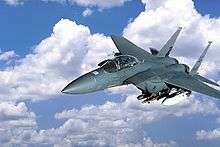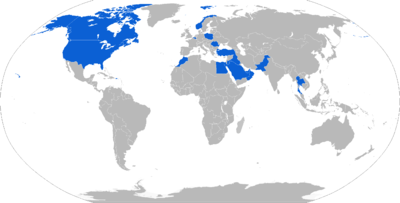Sniper Advanced Targeting Pod


The Lockheed Martin Sniper is a targeting pod for military aircraft that provides positive target identification, autonomous tracking, GPS coordinate generation, and precise weapons guidance from extended standoff ranges.
The system has been designated AN/AAQ-33 in U.S. Military Service as the Sniper Advanced Targeting Pod (ATP). Further variants are the Sniper Extended Range (XR), as well as the PANTERA export derivative of the Sniper XR. The Lockheed Martin F-35 Lightning II is built with the equivalent of the Sniper XR in its onboard sensors.[1] The most modern version is the Sniper Advanced Targeting Pod - Sensor Enhancement (ATP-SE).
Design

The Sniper is a single, lightweight targeting pod with much lower aerodynamic drag than the legacy systems it replaces . Its image processing allows aircrews to detect, identify, and engage tactical-size targets outside the range of most enemy air defenses, giving it a crucial role in the destruction of enemy air defense missions. It also supports urban engagements beyond jet noise range for counter-insurgency operations. It offers a 3-5X increase in detection range over the legacy LANTIRN system , and is currently flying on U.S. Air Force and multinational F-16, F-15, B-1B, CF-18, Harrier, A-10, B-52 and Tornado aircraft.
The pod incorporates a high definition mid-wave FLIR, dual-mode laser, visible-light HDTV, laser spot tracker, laser marker, video data link, and a digital data recorder.[2] Advanced sensors, and image processing incorporating image stabilization, enable targets to be identified at ranges which minimize exposure to defensive enemy systems. The dual-mode laser offers an eye safe mode for urban combat and training operations along with a laser-guided bomb designation laser for guiding munitions.
For target coordination with ground and air forces, a laser spot tracker, a laser marker, and an HDTV quality video down-link to ground-based controllers supports rapid target detection and identification. The Sniper can also provide high-resolution imagery for non-traditional Intelligence, surveillance and reconnaissance (NTISR) missions without taking up the centerline station on small fighter aircraft, and can maintain surveillance even when the aircraft maneuvers. As a result a 2nd, dedicated fighter aircraft isn't needed to provide protection to a dedicated ISR aircraft, which many small nations cannot afford.[3]
For ease of maintenance, Sniper's optical bed design, partitioning, and diagnostic capabilities permit two-level maintenance, eliminating costly intermediate-level support. Automated built-in testing allows maintenance personnel to isolate and replace a line replaceable unit in under 20 minutes to restore full mission-capable status.
The Sniper contains a laser designator and tracker for guiding laser-guided bombs. The pod's FLIR allows observation and tracking through smoke and clouds, and in low light / no light conditions. The CCD camera supports the same operations in visible light for most daylight conditions.
In use

In August 2001, the U.S. Air Force announced Lockheed Martin's Sniper as the winner of the Advanced Targeting Pod (ATP) competition. The contract provides for pods and associated equipment, spares, and support of the F-16 and F-15E aircraft for the total force, active-duty Air Force and Air National Guard. The U.S. Air Force initial seven-year contract for Sniper ATP has potential value in excess of $843 million. The Sniper ATP has delivered over 125 pods and the U.S. Air Force plans to procure at least 522 Sniper ATPs. The follow-on Advanced Targeting Pod - Sensor Enhancement (ATP-SE) contract was split between the Lockheed Martin Sniper and the LITENING.
In 2014, the USAF declared initial operational capability for the Sniper ATP-SE which included sensor and networking improvements.[4]
The Sniper is used on the U.S. Air Force B-52H Stratofortress, B-1B Lancer, F-15E Strike Eagle, F-16 Fighting Falcon, and A-10 Thunderbolt II. It was also used on the British Harrier GR9[5] and the Canadian CF-18 Hornet,[6] as well as being in service with Norway, Oman, Poland, Pakistan,[7] Singapore, Canada, Belgium, Turkey, Saudi Arabia, Thailand.[8][9][10]
A team of Lockheed Martin UK, BAE Systems and SELEX Galileo (formerly Selex S&AS) has successfully demonstrated and flown a Sniper ATP on board a Tornado GR4 combat aircraft.[11]
On March 27th, 2015 Lockheed Martin was awarded a sole-source contract by the US DOD worth $485,000,000 firm fixed price with minimal cost-plus-fixed-fee, indefinite-delivery/indefinite-quantity to provide multiple Sniper advanced targeting pods to the USAF.[12]
Operators

.svg.png) Belgium
Belgium
 Canada
Canada
 Egypt
Egypt
 Iraq
Iraq
 Jordan
Jordan
 Morocco
Morocco
 Norway
Norway
 Oman
Oman
 Pakistan
Pakistan
 Poland
Poland
 Romania[14]
Romania[14]
 Saudi Arabia
Saudi Arabia
 Singapore
Singapore
 Thailand
Thailand
 Turkey
Turkey
 United Arab Emirates
United Arab Emirates
 United States
United States
Specifications
- Primary Function: Positive identification, automatic tracking and laser designation
- Prime Contractor: Lockheed Martin
- Length: 94 inches (239 centimeters)
- Diameter: 11.9 inches (30 centimeters)
- Weight: 440 pounds (199 kilograms)
- Aircraft: F-15 models C/E, F-16 Block 30/40/50, A-10, B-1, B-52, CF-18, Harrier, Tornado
- Sensors: Mid-wave third generation Forward looking infrared, dual mode eye-safe, laser designator, Charge-coupled device-TV, laser spot tracker and laser designator
- Date Deployed: January 2005
- Inventory: Not available.
See also
- Similar devices
- LITENING
- AN/ASQ-228 ATFLIR
- LANTIRN
- ASELPOD
References
- ↑ "Newest U.S. Stealth Fighter ‘10 Years Behind’ Older Jets".
- ↑ http://www.af.mil/AboutUs/FactSheets/Display/tabid/224/Article/104527/sniper-pod.aspx
- ↑ http://www.lockheedmartin.com/us/products/Sniper/mfc-sniper-atp-feature-stories.html
- ↑ "U.S. Air Force Declares Initial Operational Capability for Lockheed Martin’s Sniper Advanced Targeting Pod – Sensor Enhancement". www.lockheedmartin.com. Lockheed Martin. 17 March 2014. Retrieved 17 March 2014.
- ↑ "SNIPER CONTRACT A HIT FOR UK HARRIER".
- ↑ Harrington, Caitlin (March 16, 2009), Jane's Missing or empty
|title=(help) - ↑ Lockheed Martin To Supply ATP's for Pakistan Air Force F-16s - India Defence
- ↑ Saudis Seek Sniper ATP Supplementation for F-15S
- ↑ "LOCKHEED MARTIN'S SNIPER XR ADVANCED TARGETING POD TEAM CHOSEN BY AVIATION WEEK & SPACE TECHNOLOGY AS 2004 LAURELS HONOREE".
- ↑ "Belgian Air Force buys eight Sniper XR targeting pods".
- ↑ Lockheed Martin uk demonstrates Sniper advanced targeting pod on board tornado gr4
- ↑ http://www.globalsecurity.org/military/systems/munitions/atp.htm
- ↑ http://articles.orlandosentinel.com/2013-06-05/business/os-lockheed-latest-foreign-sales-20130605_1_arms-sales-orlando-missiles-unit-joint-air-to-surface-standoff-missile
- ↑ https://www.fbo.gov/index?s=opportunity&mode=form&id=284856b0596b8c5fbfb1afc874e69d97&tab=core&tabmode=list&=
http://materion.com/Markets/DefenseandScience/OpticsandOpticalSystems/OpticalSystems.aspx
External links
| Wikimedia Commons has media related to Sniper Advanced Targeting Pod. |
- Lockheed Martin's Sniper ATP page
- "Sniper Targeting Pod Attacks From Long Standoff Ranges", Aviation Week & Space Technology, October 3, 2004.
- http://materion.com/Markets/DefenseandScience/OpticsandOpticalSystems/OpticalSystems.aspx
- http://www.lockheedmartin.com/us/news/press-releases/2015/april/mfc-lm-delivers-1000-sniper-atp.html
- http://www.strategicmaterials.dla.mil/iamthekey/Documents/Strategic%20Materials%20-%20One-Pagers%20Document.pdf "Lightweight Strategic Materials"
- http://www.ibcadvancedalloys.com/news/2015/09/09/2015/ibc-engineered-materials-awarded-hard-tooling-contract-for-lockheed-martin-s-sniper-advanced-targeting-pod-components/
| |||||||||||||||||||||||||||||||
